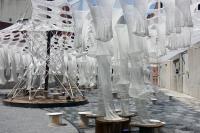Co-Op Editorial
Santa Monica, CA, USA
The design of this 4700 square foot tenant improvement evolved from the unique challenge to remodel an early 1963 Frank Gehry designed commercial structure located in the heart of downtown Santa Monica.
The client is a full service post-production facility based in Chicago. They provide every aspect of the TV commercial making process, including creative on and off line editing, film transfer, special, visual and audio effects.
Like much or our work, this project is a continuation of an ongoing inquiry. It is an ongoing research into materials and technologies as well as a re-examination of known conditions, accepted norms and established methods. This has lead us to an innovative solution and stimulating new way of approaching interior architecture. Without predefining archi-tecture, we responded directly and intuitively to the material qualities of place.
The context and program for the production studio suggests an experience ordered like a film or freeway, framing and containing reality. The design engages the user, heightens their sense of awareness, and brings a deeper understanding and vitality to their experience.
The design examines the tension between materials, form and experience. The interior can be viewed as "a skin or surface wrapper that moves in and out alternately concealing and revealing the building fabric." The layering and sculpting of the newly formed surfaces weave together disparate and contrasting materials. Recalling film director Alfred Hitchcock's interest in openings as metaphors, here, too, voids are as important as surfaces, revealing an earlier pattern of materials or use.
Of particular interest is the idea of transcending traditional craft and elevating humble materials without trying to make them into something other than what they really are. It is an attempt to find and reveal the extraordinary from within the ordinary. The exploration encourages the user to forge a deeper and more meaningful understanding of the fundamental, yet delicate relationships that exist between themselves, the natural world, its vital resources, and our collective cultures.
Two basic materials, wood and plastic are transformed from benign surfaces into sculpted space. The one hundred foot long wood wall was created by a direct transfer method. Computer models were sent directly from the architect to a computerized CNC router where 74 Glue laminated beams of varying thickness were sculpted by direct automation, virtually eliminating the traditional handcraft. Several studio entry doors were integrated into the pattern of the wood and seamlessly disappear. The result is a surface that is spatial, has depth and comes alive with movement. The perception that wood is a static dead material is ransacked. It is, in fact, alive with energy and moves through the space with its occupants and visitors.
In contrast to the carving method of the wood construction, 1/8" colored acrylic panels were layered to a thickness of 1" for the facades of the adjacent lead lined offices. The panels are backlit from large skylights located within the interior of their respective offices and are transformed into a material of considerable spatial dept and color. The movement of light and people engages and activates the entire space, creating a quality of time and movement. Light is also used as an ordering device: drawing you into and through the space. It is a register of the passage of time as well as a social connector. As in the construction of the wood wall the acrylic panels reveal the extraordinary from within something very ordinary.
In Complexity and Contradiction in Architecture, Robert Venturi writes, " A familiar thing seen in an unfamiliar context can become perceptually new as well as old." By placing objects and materials "outside the frame," a new frame of reference deepens our sense of perception. Art does not reproduce what we see; rather it makes us see.
- Architects
- Brooks + Scarpa Architects
- Location
- Santa Monica, CA, USA
- Year
- 2003








